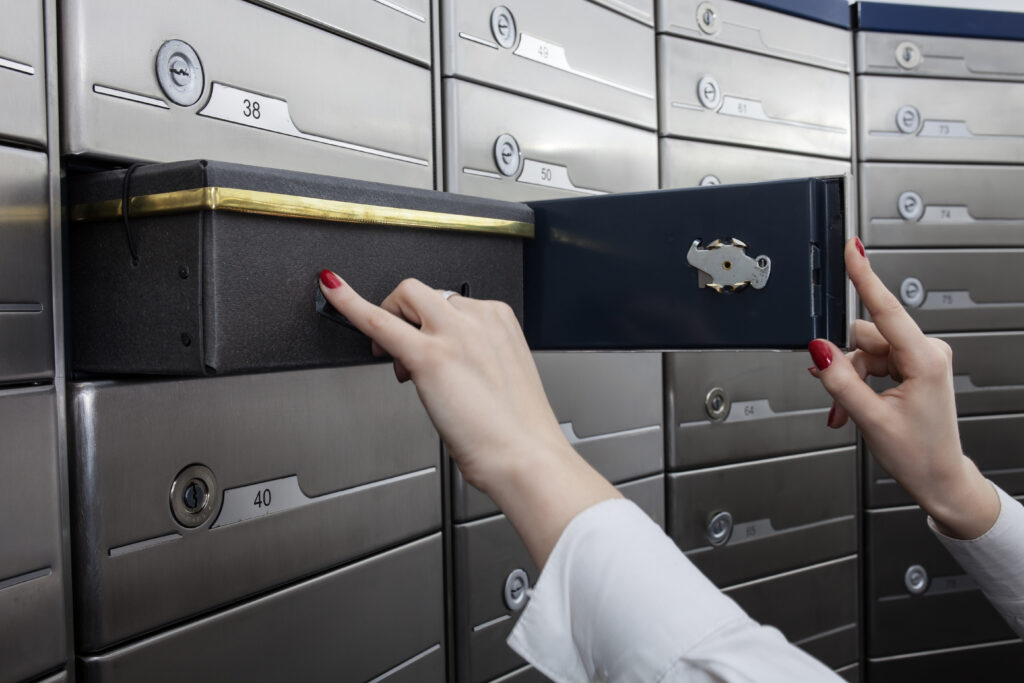Do you have family heirlooms, important documents, or valuable collectibles that you want to protect? As a senior, you’ve likely accumulated cherished items throughout your life that hold both monetary and sentimental value. But have you considered using a safety deposit box to safeguard these treasures?
There are approximately 25 million safety deposit boxes in the United States. While this may seem like a relatively small number, safety deposit boxes remain a popular choice for those seeking an extra layer of security beyond what a home safe can offer.
But what exactly is a safety deposit box, and how much does it cost?
We’ll cover the costs associated with renting a box, what items are best suited for storage, and what you should avoid keeping in your box. We’ll also discuss insurance considerations and compare safety deposit boxes to alternative storage options.
What is a Safety Deposit Box?
A safety deposit box, also known as a safe deposit box, is a secure container typically housed in a bank or credit union’s vault. To accommodate different storage needs, these boxes come in various sizes, ranging from small (3″x 5″) to large (10″x 10″) and even bigger.
The primary purpose of a safety deposit box is to provide a highly secure location for storing valuable items and important documents. Banks and credit unions offer a level of protection that is difficult to replicate at home, thanks to their advanced security measures, which often include:
- 24/7 monitoring and surveillance
- Reinforced steel and concrete vaults
- Multi-layered access control (keys, ID verification, and sometimes biometric scans)
- Fire and natural disaster protection
When you rent a safety deposit box, you’ll typically receive a key that, when used in conjunction with a master key held by the bank, grants access to your box. This dual-key system ensures that neither you nor bank employees can access the box’s contents independently, adding an extra layer of security.
Some common items people choose to store in safety deposit boxes include:
- Precious metals and rare coins
- Jewelry and family heirlooms
- Important legal documents (e.g., property deeds, car titles)
- Sentimental items (e.g., photographs, letters)
It’s important to note that while safety deposit boxes offer a high level of security, they are not insured by the bank or the government, according to the FDIC. You’ll need to obtain separate insurance to protect the contents of your box against loss or damage.
How Much is a Safety Deposit Box?
The cost of bank locker charges varies depending on several factors, such as the box size, the bank or credit union you choose, and your location. On average, you can expect to pay anywhere from $15 to $150 per year for a safety deposit box.
Factors Affecting Safety Deposit Box Pricing
- Box size: Larger boxes generally cost more than smaller ones.
- Bank or credit union: Prices can vary significantly between different financial institutions.
- Location: Rental fees may be higher in urban areas compared to rural locations.
If you’re wondering which bank has the cheapest safety deposit box, it’s best to compare local banks and credit unions. Rates can vary significantly, and some institutions may waive fees or offer promotions for new customers or seniors.
Average Annual Cost Range
Here’s a breakdown of the typical annual costs for different box sizes:
- Small boxes (3″x5″): $15 to $60
- Medium boxes (5″x5″): $30 to $100
- Large boxes (10″x10″): $50 to $150
Potential Discounts and Offers
Some banks or credit unions may offer discounts on safety deposit box rentals if you have an existing account with them. For example, you might qualify for a 50% discount on your annual rental fee if you maintain a certain minimum balance in your checking or savings accounts.
Additionally, some financial institutions may periodically offer promotions or special offers on safety deposit box rentals. When you inquire about renting a box, it’s always worth asking about any current deals or discounts.
What Should You Keep in a Safety Deposit Box?
When deciding what to store in your safety deposit box, consider items that are valuable, difficult to replace, or hold sentimental value. Here are some categories of items that are well-suited for safety deposit box storage:
Important Documents
Certain documents are crucial to keep safe and secure, as they can be challenging to replace if lost or damaged. Consider storing the following in your safety deposit box:
- Marriage, death, and birth certificates
- Property deeds and vehicle titles
- Rare or valuable books
- Important contracts and business documents
Valuable Collectibles
A safety deposit box can provide a secure storage option if you have valuable collectibles you don’t display or use regularly. Examples include:
- Rare coins or stamps
- Valuable jewelry or watches
- Precious metals (e.g., gold or silver bullion)
- Antiques or family heirlooms
If you’re a small business owner, a safety deposit box can also be used to store critical business documents, contracts, or backup data that you want to protect from theft or disaster.
Sentimental Items
Some items hold more sentimental value than monetary worth, but they are still irreplaceable. Consider protecting the following in a safety deposit box:
- Family photos or albums
- Personal letters or journals
- Military records or memorabilia
- Childhood keepsakes or mementos
When choosing items to store in your safety deposit box, consider their importance, value, and the difficulty of replacing them if they were lost, stolen, or damaged. It’s also essential to remember that you’ll only have access to your box during the bank’s normal business hours, so avoid storing anything you might need on short notice or in an emergency.
While safety deposit boxes offer a high level of security, they are not insured by the bank or the government. If you’re storing valuable items, consider purchasing separate insurance to protect them against loss or damage.
What Not to Keep in Your Safety Deposit Box
While safety deposit boxes are great for storing many types of valuable and important items, there are some things you should avoid keeping in your box:
- Cash: If you need quick access to cash, a safety deposit box isn’t the best option, as you can only retrieve it during banking hours.
- Passports and other identification: You may need these documents on short notice for travel or other purposes, so keep them in a secure place at home.
- Medical directives and living wills: In an emergency, your loved ones may need quick access to these documents to make decisions on your behalf.
- Life insurance: Avoid storing life insurance policies in your box unless someone you trust has access. In the event of your death, your beneficiaries may need to present the policy promptly to file a claim.
- Uninsured valuables: If you’re storing expensive items, ensure they are properly insured, as the bank’s insurance won’t cover the contents of your box.
Pros and Cons of Using a Safety Deposit Box
Before deciding whether a safety deposit box is right for you, consider the advantages and disadvantages:
Pros:
- Enhanced security compared to home storage
- Protection against theft, fire, and natural disasters
- Privacy and confidentiality
Cons:
- Limited accessibility during banking hours
- Annual rental fees
- No FDIC insurance for box contents
- Potential legal complications if the renter passes away
Insurance Considerations
One important thing to keep in mind is that the contents of your safety deposit box are not insured by the bank or the FDIC. If you’re storing valuable items, consider adding a rider to your homeowners’ or renters’ insurance policy to cover those items specifically.
Some insurance companies offer standalone policies for safety deposit box contents, which may provide more comprehensive coverage. Be sure to shop around and compare options to find the best policy for your needs.
Alternatives to Safety Deposit Boxes
If a safety box doesn’t fit your needs or budget, there are other secure storage options to consider:
Home safes: A high-quality, fireproof, and waterproof home safe can provide secure storage for your valuables and important documents
Digital storage: Consider scanning and storing digital copies in a secure cloud storage service or on an encrypted hard drive for important documents.
Some people prefer financial flexibility through high-yield savings accounts, which offer better interest returns while keeping your funds easily accessible—unlike storing cash or checks in a safety deposit box.
How to Rent a Safety Deposit Box
If you’ve decided that a safety deposit box is right for you, follow these steps to rent one:
- Choose a bank or credit union: When selecting a financial institution, consider factors like location, reputation, security measures, and rental fees.
- Gather necessary documents: To rent a box, you’ll typically need a government-issued ID, proof of address, and an initial payment.
- Choose a box size: Choose a size that accommodates your needs, keeping in mind that larger boxes generally have higher rental fees.
- Sign the rental agreement: Carefully review the rental agreement, which outlines your responsibilities and the bank’s policies regarding the deposit box.
- Store your items: Once you have access to your box, carefully place your items inside and ensure the box is securely locked before leaving the bank.
Keeping Your Valuables Safe and Secure
These bank safes have been offered for over 150 years, making them a valuable tool for seniors looking to protect their most precious belongings and important documents. By understanding the cost of a bank box, its benefits, and its limitations, you can make an informed decision about whether it is right for your needs.
Remember to carefully consider what items you’ll store in your box and ensure that any valuable items are properly insured. By taking these precautions and following the steps to rent and maintain your box, you can enjoy the peace of mind that comes with knowing your treasured possessions are safe and secure.
Sources
SQN Banking Systems. (n.d.). 10 facts about safe deposit boxes. Retrieved from https://sqnbankingsystems.com/blog/10-facts-about-safe-deposit-boxes/
Federal Deposit Insurance Corporation (FDIC). (2018). Five things to know about safe deposit boxes, home safes, and your valuables. Retrieved from https://www.fdic.gov/consumer-resource-center/five-things-know-about-safe-deposit-boxes-home-safes-and-your-valuables
Bankrate. (2023). Safe deposit box etiquette: What not to put in your safe box. Retrieved from https://www.bankrate.com/banking/savings/safe-deposit-box-etiquette-what-not-to-put-in-your-safe-box/
Regions Bank. (n.d.). Safe deposit box overview. Retrieved from https://www.regions.com/personal-banking/safe-deposit-box
Investopedia. (2023). Safe deposit box definition. Retrieved from https://www.investopedia.com/terms/s/safe-deposit-box.asp











